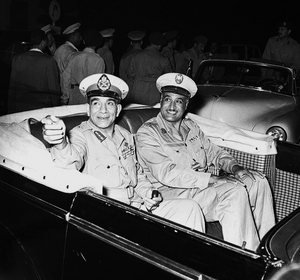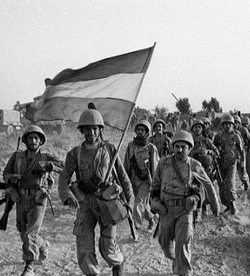Khazi Revolution
| Khazi Revolution Tir Revolution | |||
|---|---|---|---|
| Part of Zorasani unification | |||
 KRRC leader Mustafa al-Kharadji (L) with Ali Sayyad Gharazi following the King's death | |||
| Date | 11 July 1952 - 18 November 1952 (4 months, 7 days) | ||
| Location | |||
| Caused by |
| ||
| Goals | Overthrow of the Abdulkarimite monarchy Unification of Khazestan and Pardaran | ||
| Methods | |||
| Resulted in |
| ||
| Parties to the civil conflict | |||
| Lead figures | |||
| Casualties | |||
| 2,583 protesters and loyalists killed 2,800-4,000 protesters injured | |||
The Khazi Revolution (Badawiyan: ثورة العرفانية; Thawrah al-Kaṣiyyah), also known as the Tir Revolution in Pardaran (Pasdani: انقلاب تیر; Enqelâbe Tir) was a series of events that led to the overthrow of the Abdulkarimite monarchy and the establishment of an interim government led by the Khazi Revolutionary Resistance Command and the unification of Khazestan and Pardaran in December 1952 and the division of the country. The overthrow was aided by a several leftist groups and movements and by a military invasion by neighboring Pardaran.
Opposition to the King escalated with the emergence of the Khazi Revolutionary Resistance Command in 1948 as the most prominent anti-monarchist group. By 1950, the KRRC was receiving significant materiel aid from Pardaran, enabling it expand its bases of operations and its network across Khazestan. In the summer of 1952, food shortages led to bread riots and eventually mass demonstrations against the monarchy, which now began to respond with violent crackdowns. Influenced by the KRRC, the mass protests grew rapdily and spread to every major city in the country, drawing the involvement of numerous leftist groups. Between July and October, the KRRC worked to use its network within the military to under the King's authority, culminating in the Army's declaration of neutrality on November 1. On November 5, in support of the KRRC, Pardaran invaded Khazestan and seized the capital, Faidah on November 10. The following day, the King and most of his family were captured outside the capital and executed. Within hours, the KRRC under Mustafa al-Kharadji proclaimed a provisional government. During this time, significant numbers of royal court members and loyalist army units fled to the north, leading to the proclamation of the Second Kingdom of Khazestan and the country's formal division.
The revolution led to the formation of the Union of Khazestan and Pardaran and is widely considered the first major event of the Arduous Revolution, which would result in a series of major conflicts and political upheveal before directly leading to the unification of Zorasan into the Union of Zorasani Irfanic Republics in 1980. The revolution also proved the viability of Sattarism among Badawiyan anti-monarchist elements, much to the concern of Badawiyan states, who would go on to form the Mubaraz Pact in 1953.
